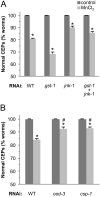The Nrf2/SKN-1-dependent glutathione S-transferase π homologue GST-1 inhibits dopamine neuron degeneration in a Caenorhabditis elegans model of manganism
- PMID: 23721876
- PMCID: PMC3773487
- DOI: 10.1016/j.neuro.2013.05.014
The Nrf2/SKN-1-dependent glutathione S-transferase π homologue GST-1 inhibits dopamine neuron degeneration in a Caenorhabditis elegans model of manganism
Abstract
Exposure to high levels of manganese (Mn) results in a neurological condition termed manganism, which is characterized by oxidative stress, abnormal dopamine (DA) signaling, and cell death. Epidemiological evidence suggests correlations with occupational exposure to Mn and the development of the movement disorder Parkinson's disease (PD), yet the molecular determinants common between the diseases are ill-defined. Glutathione S-transferases (GSTs) of the class pi (GSTπ) are phase II detoxification enzymes that conjugate both endogenous and exogenous compounds to glutathione to reduce cellular oxidative stress, and their decreased expression has recently been implicated in PD progression. In this study we demonstrate that a Caenorhabditis elegans GSTπ homologue, GST-1, inhibits Mn-induced DA neuron degeneration. We show that GST-1 is expressed in DA neurons, Mn induces GST-1 gene and protein expression, and GST-1-mediated neuroprotection is dependent on the PD-associated transcription factor Nrf2/SKN-1, as a reduction in SKN-1 gene expression results in a decrease in GST-1 protein expression and an increase in DA neuronal death. Furthermore, decreases in gene expression of the SKN-1 inhibitor WDR-23 or the GSTπ-binding cell death activator JNK/JNK-1 result in an increase in resistance to the metal. Finally, we show that the Mn-induced DA neuron degeneration is independent of the dopamine transporter DAT, but is largely dependent on the caspases CED-3 and the novel caspase CSP-1. This study identifies a C. elegans Nrf2/SKN-1-dependent GSTπ homologue, cell death effectors of GSTπ-associated xenobiotic-induced pathology, and provides the first in vivo evidence that a phase II detoxification enzyme may modulate DA neuron vulnerability in manganism.
Keywords: Caspase; DA; ECL; GFP; Manganism; Neurodegeneration; Neurotoxicity; Nrf2; PAGE; PD; Parkinson's disease; ROS; SN; TH; WT; dopamine; enhanced chemiluminescence; green fluorescent protein; polyacrylamide gel electrophoresis; reactive oxygen species; substantia nigra; tyrosine hydroxylase; wild type.
Copyright © 2013 Elsevier Inc. All rights reserved.
Conflict of interest statement
Conflict of Interest Statement: The authors state that there are no conflicts of interest.
Figures






Similar articles
-
SKN-1/Nrf2 inhibits dopamine neuron degeneration in a Caenorhabditis elegans model of methylmercury toxicity.Toxicol Sci. 2010 Dec;118(2):613-24. doi: 10.1093/toxsci/kfq285. Epub 2010 Sep 20. Toxicol Sci. 2010. PMID: 20855423 Free PMC article.
-
The divalent metal transporter homologues SMF-1/2 mediate dopamine neuron sensitivity in caenorhabditis elegans models of manganism and parkinson disease.J Biol Chem. 2009 Dec 18;284(51):35758-68. doi: 10.1074/jbc.M109.051409. J Biol Chem. 2009. PMID: 19801673 Free PMC article.
-
The metal transporter SMF-3/DMT-1 mediates aluminum-induced dopamine neuron degeneration.J Neurochem. 2013 Jan;124(1):147-57. doi: 10.1111/jnc.12072. Epub 2012 Nov 21. J Neurochem. 2013. PMID: 23106139 Free PMC article.
-
Altered manganese homeostasis: implications for BLI-3-dependent dopaminergic neurodegeneration and SKN-1 protection in C. elegans.J Trace Elem Med Biol. 2012 Jun;26(2-3):183-7. doi: 10.1016/j.jtemb.2012.03.011. Epub 2012 May 15. J Trace Elem Med Biol. 2012. PMID: 22591558 Review.
-
The Caenorhabditis elegans dopaminergic system: opportunities for insights into dopamine transport and neurodegeneration.Annu Rev Pharmacol Toxicol. 2003;43:521-44. doi: 10.1146/annurev.pharmtox.43.100901.135934. Epub 2002 Jan 10. Annu Rev Pharmacol Toxicol. 2003. PMID: 12415122 Review.
Cited by
-
Inhibition of glutathione S-transferase-pi triggers c-jun N-terminal kinase-dependent neuronal death in Zn-induced Parkinsonism.Mol Cell Biochem. 2019 Feb;452(1-2):95-104. doi: 10.1007/s11010-018-3415-8. Epub 2018 Aug 3. Mol Cell Biochem. 2019. PMID: 30076580
-
Stage-specific exposure of Caenorhabditis elegans to cadmium identifies unique transcriptomic response cascades and an uncharacterized cadmium responsive transcript.Metallomics. 2024 May 2;16(5):mfae016. doi: 10.1093/mtomcs/mfae016. Metallomics. 2024. PMID: 38549424 Free PMC article.
-
Mutations in Caenorhabditis elegans neuroligin-like glit-1, the apoptosis pathway and the calcium chaperone crt-1 increase dopaminergic neurodegeneration after 6-OHDA treatment.PLoS Genet. 2018 Jan 18;14(1):e1007106. doi: 10.1371/journal.pgen.1007106. eCollection 2018 Jan. PLoS Genet. 2018. PMID: 29346364 Free PMC article.
-
Acute exposure to a glyphosate-containing herbicide formulation inhibits Complex II and increases hydrogen peroxide in the model organism Caenorhabditis elegans.Environ Toxicol Pharmacol. 2019 Feb;66:36-42. doi: 10.1016/j.etap.2018.12.019. Epub 2018 Dec 24. Environ Toxicol Pharmacol. 2019. PMID: 30594848 Free PMC article.
-
Melatonin inhibits manganese-induced motor dysfunction and neuronal loss in mice: involvement of oxidative stress and dopaminergic neurodegeneration.Mol Neurobiol. 2015 Feb;51(1):68-88. doi: 10.1007/s12035-014-8789-3. Epub 2014 Jun 28. Mol Neurobiol. 2015. PMID: 24969583
References
-
- Bradford M. A Rapid and Sensitive Method for the Quantitation of Microgram Quantities of Protein Utilizing the Principle of Protein-Dye Binding. Anal Biochem. 1976;72:248–254. - PubMed
Publication types
MeSH terms
Substances
Grants and funding
LinkOut - more resources
Full Text Sources
Other Literature Sources
Molecular Biology Databases
Research Materials
Miscellaneous

